I. Introduction
VPNs (Virtual Private Networks) have become an essential tool for protecting data in transit over the internet. By encrypting connections and traffic, VPNs prevent unauthorized access to sensitive information. There are two main types of VPN protocols – IPsec VPN and SSL VPN. While they share some common capabilities, there are also key differences in how each one secures connections.
This article will take an in-depth, comparative look at IPsec and SSL VPN technologies. It will define what each type of VPN does, explore their technical components, analyze their relative security strengths and weaknesses, and highlight factors to consider when deciding between them. Properly evaluating the merits of IPsec vs SSL VPNs allows matching specific use case requirements to the optimal underlying VPN solution.
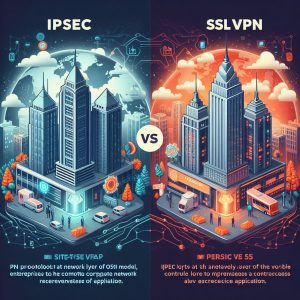
II. IPsec VPN
IPsec (Internet Protocol Security) represents one of the most widely used VPN standards, providing strong encryption for all internet traffic flowing through a tunnel between devices or networks.
What is IPsec VPN? IPsec VPNs utilize the Internet Protocol Security protocol suite to authenticate and fully encrypt traffic via VPN tunnels. Utilizing complex cryptography and security mechanisms, an IPsec connection requires installation of VPN client software to create protected pathways for remote access clients and internal corporate networks to securely communicate through.
How IPsec VPNs Work IPsec utilizes the concept of establishing virtual tunnel relationships between devices known as Security Associations. These enforce confidentiality through encryption algorithms securing data flows across the tunnel interface. Anti-replay protection guarantees packets are not intercepted or duplicated within the connection. While complex under the hood, IPsec VPN clients provide an easy way to launch and route traffic through these encrypted VPN tunnels.
Common IPsec VPN Uses IPsec VPNs see widespread enterprise usage securing remote access and site-to-site connectivity for employees, networks, and applications that deal with highly sensitive data. The full encryption model makes an IPsec VPN optimal for infrastructure components that need omnidirectional security across the entire internet traffic stack versus just application data.
Pros
Some benefits afforded by IPsec VPN technology include:
- Total network traffic encryption
- Fine-tuned control over almost all facets of the VPN tunnel
- Mandatory access granted on a case-by-case basis
Cons
Downsides to consider around IPsec VPN technology encompass:
- Configuration complexity requiring IT expertise
- Lack of scalability for large deployments
- VPN client installation needed on every device
Underlying Technology Components Critical technologies and protocols leveraged by IPsec VPN connections consist of:
- Internet Key Exchange version 2 (IKEv2) handles the mutual authentication between VPN server and client while also facilitating session key generation used within the IPsec tunnel itself for encrypting traffic flows via agreed parameters around security standards being enforced, encryption & hash algorithms adopted, etc. Diffie-Hellman key exchange integrates within IKEv2.
- Encapsulating Security Payload (ESP) provides confidentiality, data origin authentication, connectionless integrity and anti-replay services through encryption. ESP authenticates the sender and blocks unauthorized parties from modifying message contents.
- Authentication Header (AH) guarantees data integrity and authentication on every IP packet transmitted through the tunnel while detecting any changes to packet data via hashing. However, AH does not actually encrypt packet contents directly.
IPsec VPN vs. SSL VPN Fundamentally, SSL VPNs employ asymmetric public/private key pairs for encrypting communication at the application layer of the OSI networking model rather than baking encryption into the network layer like IPsec VPNs leverage. Hence IPsec handles security across the full spectrum of IP traffic, while SSL narrowly targets application-level data.
III. SSL VPN Secure Sockets Layer and its more modern Transport Layer Security (TLS) cryptographic protocols are also commonly harnessed for VPN connectivity – forming SSL VPNs.
What is SSL VPN? SSL VPN allows remote client access to internal corporate applications and resources facilitated through a secure, encrypted SSL/TLS tunnel. This leverages web browsers as clients rather than needing pre-installed VPN software. End user devices form VPN channels “on-demand”, requiring less IT administration effort.

How SSL VPN Works
Because SSL VPNs rely on secure webpage connectivity conveying encrypted traffic flows in the form of HTTP responses loaded within browsers, no specialized client software is necessary. Web-proxied application access means users invoke protected pathways to authorized resources only when needed rather than keeping perpetual VPN tunnels active.
Common SSL VPN Use Cases Thanks to easy browser-based deployments, SSL VPN usage permeates organizations supporting external partners, individual remote staff, work-from-home access needs and basic site-to-site links between branch offices, data centers or cloud environments where controlled connectivity suffices over total IP traffic encapsulation typical with IPsec.
Pros Advantages around properly leveraging SSL VPNs include:
- Simplified remote user access
- Granular policy control over application/network resource access permissions
- Support for a wider range of endpoint devices
Cons Limitations organizations may encounter with SSL revolve around:
- Data privacy vulnerabilities on public networks
- Reliant on third-party root certificates
- Session maintenance expirations
SSL VPN Technology Components Core technologies enabling SSL VPN capabilities consist of:
- Transport Layer Security (TLS) successor to SSL – facilitates authentication, privacy and data integrity between two communicating computer applications. TLS involves certificates, hash algorithms and asymmetric cryptography for security.
- Secure Shell (SSH) Utilizes public-key cryptography to facilitate remote login sessions and other secured network services between two networked devices. Primarily deployed to access text-based command line interfaces on remote systems or servers.
- Multipurpose Internet Mail Extension (MIME) Enables sending additional payloads of information across standard SMTP, defining content type headers so messages are correctly parsed. Allows encrypting message bodies themselves, attachments or other embedded resources.
IPsec VPN vs SSL VPN IPsec intrinsically weaves VPN access into the lower networking layers to deliver total site-to-site security. SSL VPNs offer a more flexible, web-based model for granular user or application data protection – but with potential gaps allowing endpoint exploits around unencrypted content delivered externally outside the VPN tunnel itself if not carefully firewalled.
IV. Comparison Between IPsec & SSL VPNs
Now that foundational knowledge has been established around what exactly IPsec and SSL VPNs are on a technical level, it’s possible to draw direct side-by-side comparisons across relevant decision-making criteria:
Speed & Performance IPsec VPNs carry more computational overhead around encrypting end-to-end traffic with algorithms like AES-256 applied omnidirectionally. However SSL only encrypts selective application payload data. Therefore SSL VPN throughput bandwidth ceiling is higher than IPsec generally – however IPsec aims to hide the entire IP footprint which is more resource intensive by design.
Security Risk Management
Arguably IPsec VPNs provide substantially greater depths of security – encompassing traffic threats like man-in-the-middle attacks, session hijacks or endpoint malware. SSL relying on web domains faces greater potential attack surfaces. However SSL VPN access limitations help minimize damage chances although data could still be intercepted externally before entering or after exiting the VPN tunnel space itself during transmission.
Technology Composition IPsec utilizes venerable enterprise VPN protocols like IKEv2 or older standards such as L2TP/IPsec weaved integrally into device operating systems and layered deeper in the network stack. SSL VPNs harness web protocols like HTTPS for facilitating proprietary socket tunnels only conveying certain permitted traffic flows in application space.
Maintenance & Configuration SSL VPN systems possess simpler deployment hurdles accessed through web URLs and browser plugin installations. Meanwhile IPsec VPN clients demand pre-configuration spanning firewall rules, address allocation, device settings across endpoint machines, which raises time investments administering VPN access permissions. SSL user access relies more on relative sessions and expiring tokens.
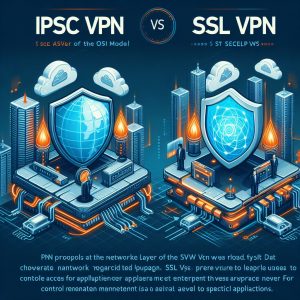
V. Conclusion
Deciding between whether an IPsec or SSL-based virtual private network solution makes the most sense requires carefully weighing intended use cases against each VPN technology’s comparative strengths and weaknesses.
Balancing endpoints needing connectivity, types of data assets being transferred, existing business infrastructure complexity, local expertise administering systems, and cost constraints are all critical inputs towards determining if SSL’s selective access models or IPsec’s blanket encryption approach fulfills security responsibilities adequately.
IT professionals may use these comprehensive VPN evaluations highlighting key metrics like performance impact, vulnerabilities protected against, ease of management, accessibility requirements and transparency needs to construct informed, unbiased recommendations around matching IPsec or SSL capabilities towards fulfilling specific organizational privacy and access demands at hand. There exist merits to both implementations – choosing correctly rests on needs not vendor marketing.
By establishing clarity upfront around must-have capabilities spanning speed, risk prevention scope, configuration barriers and flexibilities – while ignoring assumptions or personal bias – the optimal IPsec vs SSL VPN environment naturally reveals itself positioning teams for success safeguarding assets long term. Approaching IT solutions through an impartial, structured lens leads to ideal outcomes.
Introduction
Overwatch by Blizzard Entertainment has become one of the world’s most popular online multiplayer games since launching in 2016, pitting two teams of players against each other in intense first-person shooting battles. As a competitive experience, having a perfectly optimized and secure internet connection is key. This is where utilizing a high-performance gaming VPN can greatly enhance and protect your Overwatch sessions.
VPNs (virtual private networks) work by encrypting your device’s internet traffic through remote servers run by the provider, hiding your real IP address. Connecting to a VPN server close to Overwatch’s gameplay servers can significantly reduce lag, ping issues, and latency problems during crucial matches. Gaming VPNs also safeguard your personal information and location by masking your IP, provide protection against DDoS attacks from sore losers, and may even allow accessing Overwatch content that has been region-restricted in your country.
This detailed guide covers the multitude of benefits afforded by marrying Overwatch together with one of 2023’s top-rated virtual private network services optimized for gaming traffic and security.
Benefits of Using a VPN for Overwatch While Overwatch itself is free-to-play, purchasing a premium VPN subscription unlocks key advantages not possible when playing without one:
Lower Ping & Latency
Excessive ping, latency, rubberbanding and lag during Overwatch matches relentlessly hampers your ability to be an effective teammate and limits progression up the competitive ranks. Connecting to a geographically nearby VPN server reduces transmission delays, lowers ping down to 30ms or under, stabilizes smooth connections essential for competitive gaming.

Access Game Regions & Content
Certain Overwatch gaming servers, content updates, or competitions may be partially region restricted depending on your location. Using a VPN gets around these artificial barriers, letting you access overseas game servers for increased variety and content libraries that are unavailable locally.
Enhanced Security Protections
Unfortunately the online gaming community sees frequent hacking, cheating, swatting attacks, DDoS and doxxing by sore losers against more skilled players just to embarrass them. Powerful VPN encryption and online anonymity makes executing these exploits much more difficult. VPNs also prevent ISPs from throttling bandwidth-hungry gaming traffic.
Top VPNs for Overwatch
The virtual private network ecosystem offers gamers an extensive range of services to consider – but not all VPN providers are created equal when it comes to protecting traffic-sensitive games like Overwatch that demand ultra low-latency connections for top-tier play. Below represents the best performing and most secure VPN options available in 2023 for vastly improving your Overwatch experience:
- ExpressVPN – Best VPN for Low Ping & Anti-DDoS Boasting 3,000+ high-speed VPN servers in 94 different countries around the world, ExpressVPN has the sheer size and scale to deliver max Overwatch optimization no matter your location. Unique VPN protocol implementations like Lightway and Speed Test connections ensure industry-leading speeds and lowest possible ping times.
Not only does ExpressVPN shield your IP address and location for anonymous gaming, but it also offers powerful DDoS protection via private, unlisted servers that are nearly impossible for attackers to find and flood. Combine this with unlimited bandwidth and five simultaneous device connections per account, ExpressVPN satisfies every requirement for buttery smooth Overwatch play protected against cyber attacks.
- PureVPN – Optimized Gaming Connectivity PureVPN manages an expansive server fleet spanning over 6500 machines across 78 countries – including dedicated VPN servers strictly configured for uninterrupted, lag-free gaming connectivity. By channeling your traffic through PureVPN’s gaming infrastructure, latency and ping is minimized to critical Overwatch server clusters in your region.
This gaming focus also removes common issues plaguing open-internet pathways like severe packet loss and ISP throttling that ruin match performance. Dedicated IP availability also solidifies you to one consistent server address. Convenient apps across all platforms – Windows, macOS, Android, iOS, browser extensions and even gaming consoles like PS4/Xbox One makes setup effortless.
- IPVanish – Most Secure Gaming VPN
Backed by a large server presence covering 75+ global regions, IPVanish makes it simple to find a low-latency Overwatch VPN server near real-time gameplay servers – meaning faster speeds and reduced lag even during intense ranked Overwatch matches. Independently audited to have a strict no-logging policy for all user activity, IPVanish adds world-class application-based and network-level encryption to your Overwatch sessions for totally incognito gaming.
This enhanced anti-DDoS protection and scramble against web threats also defends against connection issues like sudden latency spikes, rubber banding or choppy performance often arising when playing Overwatch on public WiFi or shared networks.
- AtlasVPN – Free Overwatch Voice Chat Security If you engage heavily in Overwatch’s real-time player voice chat features for coordinating with teammates, AtlasVPN is a superb free VPN solution for shielding these sensitive voice communications from exploitation by snoopers, hackers, and harassers wanting to expose your location.
By hiding your IP address from voice data transmission through Atlas’ global server network spanning 53 regions worldwide, you prevent stalkers from geo-locating your physical address and launching offline harassment. Unlimited free data usage with AtlasVPN coupled with strong AES-256 server encryption provides simple yet effective security for Overwatch voice chat users focused on privacy.
- NordVPN – Expansive Server Selection As one of the largest premium VPN networks on the market encompassing 5,500+ servers hosted in 59 different countries internationally, NordVPN offers an overwhelming bounty of nearby server options for connecting close-proximity to Overwatch game servers – yielding much improved latency, speeds and lag reduction during matches.
Specific server recommendations displayed right inside NordVPN’s desktop and mobile apps points users to the ideal low-ping nodes for gaming. NordLynx VPN protocol and Threat Protection monitoring further enhance security protections against DDoS and geo-blocking.
- Surfshark – Affordable Overwatch Ping Improvement
Delivering excellent global VPN coverage boasting over 3,200 servers in 100+ territories for less than $3 monthly, Surfshark is arguably the best value gaming VPN for massively driving down Overwatch ping times regardless of location. Surfshark’s private DNS and secure core protocols like WireGuardVPN and Cloak narrow the physical distance between your device and live Overwatch servers.
This allows lag-sensitive traffic to flow freely without ISP restrictions that commonly disrupt gaming connectivity resulting in huge ping spikes and choking bandwidth. Surfshark also offers anti-malware filtering and alert tools called HackLock that warn against suspicious incoming traffic behavior while playing Overwatch.
- CyberGhost – Dedicated Gaming Infrastructure CyberGhost smartly operates a subsection of its considerable 7,400+ global VPN server fleet specifically optimized for gamers wanting the lowest pings and fluid game streaming across titles like Overwatch, Fortnite, CS:GO and more. By intelligently routing your traffic through these dedicated gaming nodes strategically positioned near major multiplayer game servers, latency plummets below 100ms with zero packet loss.
CyberGhost also provides easy one-click server recommendations based on which happen to currently provide the slickest Overwatch ping metrics from your location. Windows and Mac desktop apps make launching and managing gaming connections simple – unlocking better performance in Overwatch when you need it most.
- Private Internet Access – Robust DDoS Prevention
Private Internet Access is anchored by a no-logging VPN network spanning 83 defined regions internationally through which all your device’s gaming traffic is masked from snoopers and hackers through AES-256 bit encryption. For Overwatch players suffering frequent DDoS attacks mid-match attempting to embarrass them, PIA’s included DDoS protection prevents these malicious efforts by anonymizing your IP footprint.
MACE anti-malware tools offer further real-time monitoring against suspicious incoming packets and data that could be targeting your connectivity. Super-low ping speeds under 30ms pave the way for lag-free Overwatch play no matter your location around the globe.

How to Choose the Best VPN for Overwatch
Evaluating virtual private network services for optimized and secure Overwatch access involves weighing several key criteria covered below when comparing providers:
Speed & Latency Benchmarks – The top priority is select Overwatch gaming VPNs with proven speed test results reflecting low single-digit ping times and negligible latency when connecting nearby servers. These indicate quality infrastructure best supporting fluid gameplay.
Expansive Server Network – Having the widest selection of VPN server locations domestically and internationally maximizes the chances you’ll find one hosted closest to Overwatch’s server access points needed for reducing lag.
Platform App Availability – VPN providers offering native apps across Windows, macOS, iOS, Android, gaming consoles and router firmware makes accessing your account and launching your optimized gaming VPN for Overwatch extremely simple from all devices.
Threat Protection & Security – Robust VPN encryption plus consistent monitoring against suspicious incoming traffic and known malicious IP ranges protects Overwatch players from cheating, swatting and DDoS – letting you game safely.
Optimized Gaming Protocols – Purpose-built VPN protocols refined to prioritize ultra low-latency connectivity over peak speeds preserves competitive integrity of Overwatch and other multiplayer titles that are highly latency-sensitive during play.
Introduction
NordVPN is one of the most popular virtual private network (VPN) services available today. As a VPN, NordVPN encrypts your internet traffic and routes it through remote servers for increased privacy and security online. However, there may come a time when you decide to switch to a different VPN provider, no longer need the extra security of a VPN, or are having technical issues with the NordVPN service. When that happens, completely uninstalling the NordVPN app and associated software is important to ensure no leftover processes are still running or private data remains on your device.
This comprehensive guide will walk through the necessary steps to fully remove and delete NordVPN on all major operating systems, including Windows PCs, Mac computers, Android and iOS mobile devices, and Linux installations. Thoroughly following the provided uninstall directions per your device OS will guarantee the NordVPN app and any related connections are wiped properly during the transition away from using this VPN provider’s platform.

Uninstalling NordVPN on Windows
If you have been using the official NordVPN Windows client app and now need to get rid of it from your computer, performing the following actions completely removes the software:
- Disconnect NordVPN Session First, ensure NordVPN is currently disconnected by right-clicking the blue “N” system tray icon and selecting “Disconnect.” This shuts down the active VPN session before uninstalling the client app itself.
- Exit NordVPN Next, right-click the “N” icon again and choose “Quit app” so the NordVPN process stops running in the background on your computer.
- Access Windows Apps Folder Then access the Windows “Apps” folder where desktop applications are stored, either through the Start menu search bar or by navigating to “C:\Program Files\NordVPN” in Windows Explorer.
- Select Uninstall Inside the NordVPN program folder, right-click directly on the “NordVPN” app tile and choose “Uninstall” from the action menu.
- Confirm Uninstall A popup prompt will ask to confirm removal – click “Yes” to authorize deleting NordVPN and all associated files/settings.
After following these steps no NordVPN-related processes or data should persist on your Windows machine, guaranteeing a clean and successful uninstall.
Uninstalling NordVPN on macOS
The process for fully removing NordVPN on an Apple Mac computer is very similar to the Windows OS method using the desktop Finder app:
- Disconnect NordVPN Like on Windows, start by disconnecting your active NordVPN connection via the menu bar icon next to your username. Terminate the session first before uninstalling the app.
- Quit NordVPN
Next right-click on the “NordVPN” menu bar icon itself and select “Quit NordVPN” to ensure the app fully stops running in the background.
- Access macOS Applications Folder Via Finder, go to the main “Applications” folder containing all your installed macOS software programs. This can be accessed through the Finder sidebar or navigating to your user account home folder.
- Drag NordVPN to Trash Inside the Applications folder, click and drag the “NordVPN” program file directly to the Trash bin icon in your Dock.
- Confirm Trash Deletion Finally, right click on the Trash icon itself and hit “Empty Trash” to authorize permanent app removal.
Those 5 steps will cleanly uninstall NordVPN and all related processes from a Mac computer as long as you ensure the active app session has been closed before deleting it.

Uninstalling NordVPN on Android
Removing NordVPN from an Android mobile device requires accessing your installed app settings:
- Open Android Settings First open the “Settings” menu, typically denoted by a gear icon, on your Android device. This houses all configurable options for installed services.
- Select Apps or Application Manager Next choose the “Apps” or “Application Manager” selection which allows managing all downloaded application content. On some Android devices this may be labeled “Apps & Notifications.”
- Locate NordVPN Inside the App Manager menu, scroll and browse your full list of installed applications until you find the application file simply titled “NordVPN”. Tap to open its configuration options.
- Tap Uninstall With the NordVPN app selected, tap the “Uninstall” button which immediately triggers removing the VPN program and its associated background services, passwords, cached data and permissions.
- Confirm Removal A pop-up prompt will ask you to “OK” or confirm deletion – authorize the NordVPN uninstall process by tapping this final confirmation button.
Once confirmed and completed, the selected app and any lingering services will be permanently erased from your Android device.
Uninstalling NordVPN on iOS
Apple iPhone and iPad devices also store installed applications locally which need to be removed before transitioning away from the NordVPN platform:
- Access Settings Open the main “Settings” app which manages configurations for all apps and system services on iOS.
- Tap General Scroll down and select the “General” settings group towards the top of the menu which houses important device preferences.
- Choose iPhone Storage
Next select “iPhone Storage” (or “iPad Storage” depending on your device) which facilitates deleting downloaded apps to free up disk space.
- Select NordVPN Inside iPhone/iPad storage settings, scroll and tap the “NordVPN” application file to open its uninstall/offload options.
- Tap Delete App On the info screen presented for the NordVPN app, tap the option marked “Delete App” – this immediately schedules complete removal.
- Confirm Deletion
Finally, authorize NordVPN’s deletion in the pop-up prompt saying “This will delete NordVPN and all related data. The app will be uninstalled.” Tap “Delete” to confirm.
Once the pending deletion finishes processing, the app disappears from your iOS device’s home screen and Settings menu signaling all NordVPN-related services have been successfully uninstalled and wiped from your iPhone or iPad.
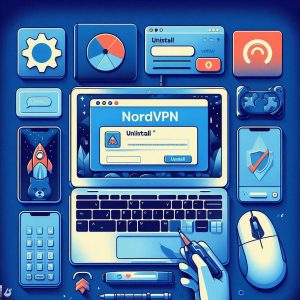
Uninstalling NordVPN on Linux
Most Linux distributions like Ubuntu also use the apt command line tool for streamlined software installation and removal:
- Open Terminal
In a distro running NordVPN like Ubuntu, Debian or Linux Mint, first open the primary command line interface called Terminal which is used to issue system commands.
- Purge NordVPN Packages
Next type the following apt terminal command to automatically uninstall NordVPN and scrub all accompanying configuration files and data:
sudo apt-get --purge remove 'nordvpn*'
You’ll be asked to enter your administrator password before NordVPN deletes.
Alternatively, the step-wise terminal commands would be:
sudo dpkg -P nordvpn
sudo dpkg -P nordvpn-release
Which also accomplishes fully removing all NordVPN-related packages from the Linux system via sudo permissions.
- Confirm Removal After pressing enter, the Terminal displays output reflecting the progress of NordVPN’s uninstallation – ending with a concise “Successfully removed” message upon completing all associated package deletion and cleanup.
Using sudo terminal commands to purge NordVPN ensures every related daemon, dependency and settings file gets eliminated from your Linux machine during this transition away from having the VPN client installed locally.
Removing Connections Without NordVPN App
Some users may prefer manually configuring VPN connections rather than using the official NordVPN desktop or mobile apps. In these cases where NordVPN customer support provides custom OpenVPN, IKEv2 configuration files or you directly import third-party VPN settings into your operating system instead, be sure to delete the established networked connection profiles.
On Windows 10, open Network Settings > VPN and remove any connection titled “NordVPN” under the VPN provider names list. On iOS, visit General > VPN > NordVPN and tap Delete VPN at bottom. On Android tap the gear icon Settings > Network & Internet > Advanced > VPN and delete any “NordVPN” profiles. And for Linux, removing the downloaded OpenVPN config files from the /etc/openvpn directory using Terminal erases custom VPN connections.
Fully wipe all established NordVPN connection profiles that have been imported separately outside the official apps to prevent lingering unauthorized VPN access.
Conclusion
Transitioning away from NordVPN or switching VPN providers requires thoroughly removing all applications, account data, settings modifications and active VPN connections that persist across various devices like Windows PCs, iOS/Android phones, Macs and Linux distributions.
Carefully work step-by-step through each platform’s necessary deletion process per this uninstall guide to guarantee complete removal of NordVPN software and dependencies. On desktop interfaces like Windows and macOS, browse installed applications and drag/delete the NordVPN item directly to the Bin/Trash after disconnecting any active sessions. On mobile, deleting the app itself via Uninstall on Android or Delete App on iOS erases all on-device traces after confirming removal. And on Linux, purging all NordVPN-related packages using sudo apt-get --purge remove terminal commands scrubs all remote VPN access, data, and modifcations.
Additionally, be vigilant by removing manual OpenVPN/IKEv2 client profiles not inside the main NordVPN apps that could still be routing traffic through this provider’s remote servers even after deleting the primary client software locally on each device type during your migration away from the platform.
Introduction
A VPN (Virtual Private Network) has become an essential tool for protecting your privacy and security online. When connected to a VPN, your device is assigned a unique VPN IP address that helps shield your real IP address and location. Understanding your specific VPN IP address is key to ensuring your VPN connection is configured properly and preventing any leaks of your private data. This guide provides an in-depth look at what a VPN IP address is, how to find your address, and steps you can take to change it if needed.
Understanding VPN IP Addresses
A VPN allows devices to securely connect to a private network over the public internet. This protects your web traffic by hiding your real IP address behind your VPN provider’s IP address via an encrypted tunnel. A VPN IP address refers to this temporary address assigned by the VPN server you connect to.
Unlike your default public IP address which could reveal your approximate location and internet service provider, a VPN IP address helps ensure online anonymity by masking your identifying data. VPN IP addresses are usually shared across many VPN users, making it difficult for sites or your internet provider to pinpoint your activity.
Using a trustworthy VPN service for all your internet traffic is crucial to guard against hacking, censorship, and other privacy threats online. Features like military-grade encryption, zero-logging policies, and shared IP addresses are what make VPNs essential for data security.

How to Find Your VPN IP Address
Checking your VPN’s IP address manually is easy using your device’s network settings, specialized IP testing tools, or asking your VPN provider directly:
- Check Device Network Settings On most devices like Windows PCs, Macs, iPhones and Android phones you can find connection status details through your network or Wi-Fi settings which show your current VPN IP address.
For example on an iPhone, go to Settings > General > VPN to view status and IP details for your active VPN connection. On a Mac, click the Wi-Fi icon menu bar > Open Network Preferences to view network information including your VPN IP and server location.
- Use a VPN Leak Testing Tool There are many reliable third party websites and apps that instantly check if your VPN is leaking any data or if your IP address appears hidden, including IPLeak.net, DNSLeakTest.com, and IPChecker. These check your web browser’s traffic while connected to your VPN and confirm if leaks are exposed.
Browser extensions like WebRTC Leak Prevent can further alert you to any leaks of your underlying public IP address while using your VPN. Running periodic leak tests ensures your real IP stays hidden.
- Contact Your VPN Provider Reputable VPN providers have helpful and responsive customer support teams available 24/7. If you cannot seem to access or verify your assigned VPN IP address through other methods, you can open a support ticket requesting details on your active VPN IPs. Most providers have login portals showing your current IP address within your account dashboard as well.
Understanding Your VPN IP Address VPN IP addresses come in a couple common formats – either as an IPv4 address (the older and more common format) or an IPv6 address (the newest system slowly being adopted). Here is a breakdown:
IPv4 Address Format: This still remains the dominant address scheme used online. An example IPv4 VPN IP would look like “185.207.204.169”. It consists of 4 sets of numbers ranging 0-255, separated by periods. This numbering combo helps identify subnets, locations, and specific devices uniquely.
IPv6 Address Format: The next generation IP addressing format represented by 32 digit combos containing letters and numbers too, like “2607:D1C2:A012:767::93BF”. This vast address space supports the rapid global growth rate of internet-connected devices and networks.
Whether your VPN provides an IPv4 or IPv6 address, it likely will have shared public IP characteristics – meaning the address is rotated frequently across many VPN users for enhanced anonymity. You can also receive dedicated IP addresses from business/enterprise VPN plans which assign you the same IP each session for improved stability.

How to Change Your VPN IP Address
Some reasons you may want to manually change your VPN’s IP address include wanting greater location anonymity, accessing geo-blocked content, improving speeds if your allocated IP is slow, or resolving any VPN connection errors popping up. Here are a few methods to easily switch VPN IP addresses:
- Switch to different VPN Server Location Within your VPN app/account settings, choose to connect via another server location from their list of global server options. By switching server country or city, your account gets assigned a brand new IP address local to that location which helps rotation and privacy.
- Use VPN Provider with Multiple Connection IPs To diversify your anonymity further, use a VPN company providing regular IP cycling across their servers along with options to reconnect instantly to grab new IPs as needed like Surfshark’s feature “MultiHop”. This automatically reroutes your traffic through multiple backend servers to get fresh IP addresses.
- Select Dedicated IP Addresses Some VPN providers allow enterprise accounts to purchase private, dedicated IP allocation as an add-on – meaning you receive permanent static IPs rather than frequently changing shared ones. Dedicated IPs enhance account performance, support whitelisting, and maintain session persistence.
Conclusion
Understanding exactly which VPN IP address you are using at any given time while connected privately on public Wi-Fi or browsing at home is vital knowledge to have. Monitoring your VPN IP ensures that your real IP stays concealed for anonymous browsing, secures your connection against data leaks, and allows changing IPs as a privacy best practice through your VPN app’s settings or connected server location.
This guide covered precise steps to easily find your active VPN IP address displayed directly on your device’s network settings next to your connected VPN server name, via IP address testing tools, or from consulting your VPN provider’s customer support team. You also learned critical context around IP address formats, the difference between public, private, shared, and dedicated IPs that VPN services assign to protect your online activity.
Equipped with this working knowledge around checking and modifying VPN IP addresses as needed, readers can now confidently use top-tier VPN services to guard their privacy across networks while also troubleshooting connections issues if they arise. Just remember to consistently verify your current VPN IP using a combination of the methods listed above for optimal security and performance.
I. Introduction
NordVPN is one of the most popular virtual private network (VPN) services on the market, used by millions of people worldwide to protect their privacy and security online. However, some NordVPN users may eventually decide they want to cancel their subscription and request a refund. NordVPN offers a 30-day money-back guarantee, allowing users to get a full refund within the first month.
This article will provide an in-depth explanation of NordVPN’s refund policy, detailing how to cancel a NordVPN subscription and get your money back. It will also cover reasons why you may not receive a refund, discuss NordVPN’s free trial option, explain how to fully cancel a NordVPN subscription, and suggest alternative VPN services to consider instead of NordVPN.

II. How to cancel NordVPN subscription and get a refund
If you want to cancel your NordVPN subscription within 30 days and get a full refund, the process is relatively simple. Here are the basic steps:
Contact NordVPN Customer Support The first step is to contact NordVPN’s customer support team directly and request a refund. You can submit a cancellation and refund request via NordVPN’s live chat feature or by emailing [email protected]. Provide your order number or other account details when asking for a refund.
Uninstall NordVPN App Next, uninstall the NordVPN application from any devices where you have it installed. Removing the app ensures you are no longer connected to NordVPN’s servers and no longer using the VPN service after cancelling.
Find a Good Alternative VPN
With your NordVPN subscription now cancelled and refunded, you may want to research alternative VPN providers that better suit your privacy needs or budget. Some top-rated alternatives to consider include ExpressVPN, Surfshark, CyberGhost, and Private Internet Access.
III. Reasons Why You May Not Get a Refund from NordVPN
While NordVPN does offer a 30-day money-back guarantee on all annual subscription plans, there are a few scenarios where you still may not receive a refund, including:
Purchased With Prepaid Card If you purchased your NordVPN subscription using a gift card or prepaid debit card, you likely forfeit the refund since the card has already been redeemed. NordVPN cannot credit back a prepaid purchase.
Violated Terms of Service
You are also not eligible for a NordVPN refund if you have violated their Terms of Service agreement in any way. This could include things like hacking, spamming, or other illegal activity when connected to NordVPN’s servers.
Past Refund Period NordVPN only allows subscription refunds within 30 days of your initial purchase. If it has been over 30 days since you paid for your NordVPN subscription, you are no longer eligible for a money-back guarantee refund.
Purchased Via Third Party
If you originally bought your NordVPN plan on iTunes, the Google Play Store, Amazon, or another third-party vendor, refund policies can differ. You may need to request the refund directly from that marketplace instead of NordVPN.

IV. NordVPN Free Trial
Before committing to a paid NordVPN subscription, new users can test out the VPN service through NordVPN’s 30-day money-back guarantee, which acts as an official free trial.
The company also offers an exclusive 7-day free trial via partnerships with various review websites. When signing up for NordVPN via one of their affiliate partners, users can access a short 7-day trial to evaluate NordVPN’s performance before paying.
30-Day Money-Back Guarantee The 30-day refund policy allows new NordVPN subscribers to use all features of the VPN service for a full month risk-free. If you cancel within 30 days, you receive a full refund. It serves as an unofficial free trial of the platform.
While NordVPN does not have an official free trial apart from partners, the 30-day money-back guarantee gives you adequate time to thoroughly test the VPN service before committing to a long-term subscription.
V. How to Cancel NordVPN Subscription
If you used NordVPN’s free trial period or 30 day money-back guarantee and still don’t want to continue your subscription, canceling is quick and easy:
- Contact NordVPN Support: Reach out to NordVPN’s customer support team via live chat or email. Specify you want to cancel your account.
- Disable Auto-Renewal: The next step is to disable future automatic billing for the subscription so you are not charged again after canceling.
You can toggle auto-renewal off via the Payment Settings section of your NordAccount dashboard.
- Uninstall NordVPN: Uninstall the NordVPN application completely from all of your devices after canceling your account.
- Use VPN Alternative: You may choose to shop around for a new VPN service provider that better meets your needs or budget long-term since you are no longer a NordVPN member.
Following this simple 4-step cancellation process ensures your NordVPN account is closed and set up for a refund to be processed to your original payment method within 5-7 business days.

VI. Alternative VPNs
If after trying out NordVPN you found the service did not meet your expectations or needs, you have plenty of alternative VPN options to consider for protecting your online privacy and security instead, including:
ExpressVPN One of the top VPN providers overall in terms of speed, reliability, and security. More expensive than NordVPN but offers best-in-class performance and a large server network spread across 94 different countries.
Surfshark Offers very affordable subscription plans starting at just a couple dollars per month. Surfshark allows unlimited simultaneous connections and has a private DNS and leak protection.
CyberGhost Has an extensive server park with over 7400 VPN servers available across 90 different countries. Excellent speeds and a reliable no-logging policy around user data and traffic.
Private Internet Access (PIA) A budget-friendly VPN solution with a reliable network of servers across 46 countries. Offers robust encryption and privacy tools like an advanced ad/malware blocker.
There are also other NordVPN alternatives like ProtonVPN, IPVanish, TunnelBear, and Hotspot Shield – each VPN provider specializing in certain areas like speed, anonymity, security features, or price.
VII. Conclusion
In summary, NordVPN provides a 30-day refund policy for unsatisfied subscribers. To cancel a NordVPN subscription within 30 days and get your money back, you need to contact customer service, disable auto-renewal on your account, uninstall NordVPN software, and find an alternative VPN service if you still require the privacy and security features of a VPN.
You may forfeit the ability to get a NordVPN refund if you violated Terms of Service, purchased using non-refundable payment methods, or missed the 30-day cutoff. While not having a true free trial, the 30-day money back guarantee allows you to effectively “test” the service for a month.
If you tried NordVPN but want to switch, there are many capable VPN alternatives to meet your needs – whether that means getting better performance with ExpressVPN, a cheaper plan from Surfshark or CyberGhost, or robust privacy tools through Private Internet Access.
I. Introduction
A VPN or Virtual Private Network detector is a technology used to identify VPN traffic across networks and block or restrict it accordingly. With rising VPN usage to bypass censorship or geographically restricted content, more authoritarian regimes and organizations are motivated to detect encrypted tunnels.
Understanding tactics of VPN detection arms security engineers to better mask connections. Likewise, grasping technology underlying resistant protocols lets hobbyists counteract blocks even if circumvention legality remains contentious. This guide will analyze common VPN detection techniques and how protocols evolve to evade them.
II. Overview of VPN Detection Technologies
We first survey protocols that VPN detectors strive to identify amid other traffic along with strategies that discovery engines employ to recognize encrypted flows.
Explanation of Various VPN and Proxy Protocols
OpenVPN – Utilizes TLS over TCP port 443 with optionally CBC ciphers for SSL encryption. Difficult for basic DPI due to resemblance to HTTPS but certificate-based handshake detectable.
L2TP/IPSec – Layer 2 Tunneling Protocol wrapped with IP Security encapsulation. Native support on various client platforms but insecure IKEv1 key exchanges red-flag tunneled traffic.
WireGuard – Novel handshake-less protocol using public keys for authentication. Chameleon spoofing further obscures but port number consistency hints at VPN.
SoftEther – Multi-protocol VPN platform aggregating TLS, L2TP, IPsec, and Ethernet traffic efficiently. Easily fingerprinted from company-registered CAs and TLS SNI data leaks.
SSTP – Proprietary SSL-VPN from Microsoft transmitted over port 443. Mostly undetectable aside from PPP headers exposed with SSL inspection.
Shadowsocks – Socks5 proxy using custom asymmetric encryption secured by passphrase salts. Difficult to distinguish from actual socket applications given dynamic headers.
Tor – Onion routing overlay using TLS encapsulation to randomly chain proxy hops. Entry and exit nodes conceal inner traffic sources despite traceability risks.
Common protocols thus vary drastically in capacities to disguise VPN traffic depending on encryption, port usage, and handshake patterns. Those relying on more widely used standards like TLS exhibit cracks while bespoke anonymous networks mask data better.

Discussion of Obfuscation Techniques Used to Evade VPN Detection
Advanced VPN platforms utilize various obfuscations to minimize detectability:
Handshakeless Protocols – WireGuard avoids initial key exchange handshakes characteristic of OpenVPN and IPSec. Removing this reveals no measurable fingerprint before encryption starts.
Domain Fronting – Hosting VPN ingress on CDNs masks servers behind legitimate platforms like Cloudfront. Exit traffic appears to originate from known sites rather than secret VPN clusters.
Port Hopping – Spinning up new ports continuously forces inspectors to check wider ranges. Combined with false positives on common ports, this taxes detector bandwidth.
Steganography – Wireshark and other tools overlay encryption on image data carriers. DPI has difficulty distinguishing secret VPN transfers hidden within cat memes or baby photos.
Chaff Traffic – Injecting high volumes of fake traffic alongside genuine VPN payload exhausts classifiers dependent on detecting known cipher suites. Extra noise drowns out real streams.
Protocol Impersonation – Making VPN transmission adhere to expected vectors of other protocols like SOAP, SQL, or memcache evades assumption-driven DPI flagging for anomalies.
Blending VPN flows with high volumes of allowed protocols compel adversaries to choose between over-blocking legal traffic or allowing policy-violating VPN usage.
III. Case Studies
Understanding specific instances of VPN detection aids avoiding broader pitfalls:
Examples of Countries or Organizations Detecting and Blocking VPN Traffic
China – The Great Firewall monitors connection attempts to known IPs of popular VPN providers via government-controlled ISPs and cuts TCP streams showing TLS anomalies. Periodic IP rotations combined with handshake masking circumvent basic GFW blocks.
Iran – By forcing government-issued TLS certificates and hashes on all inbound HTTP traffic, Iran specifically identifies unsanctioned OpenVPN usage for citizens and throttles speeds severely. Outbound-only approved VPNs still permit some traffic tunneling.
UAE – VoIP and VPN tools officially necessitate licenses from the Telecoms Regulatory Authority (TRA) costing over $100,000 annually in the UAE. In practice unapproved VPN usage results in service termination while technically-savvy VPN protocol hopping avoids detection still.
Cisco Umbrella – Many school and enterprise networks rely on Cloud Delivered Security services that specifically blacklist known commercial VPN endpoints. Private self-hosted servers with domain-fronting C2 configurations evade these basic corporate blocks.
Impact of VPN Detection on Users and Server Operators
The detrimental effects of VPN detection include:
- Severe throttling renders VPN connections unusable, limiting access to information and inhibiting free speech.
- Outright service cutoffs disrupt both work and personal activities, forcing factory resets to temporarily regain internet without protections.
- Suppressing circumvention tool usage compels more visible direct dissent, prompting authoritarian crackdowns against visible activists over simple policy disagreements.
Likewise for self-hosted VPN operators, detection consequences also scale in severity:
- Cheaper VPS providers frequently shut down servers violating infrastructure use policies when discovered. This causes service disruptions even if more permissive hosts subsequently fill gaps.
- Regional or national ISPs may permanently blacklist sites hosting VPN access considered in violation of censorship regulations.
- Operators risk being tracked down via WHOIS records or VPS account detailsleading and legally prosecutedgiven ambiguity over circumvention rights globally.
So both users and proxy providers face severe disruptions, costs, legal risks, and personal safety hazards once authorities identify secret access services directly enabling policy violation or perceived moral wrongdoing. The abstraction of VPN usage from these physical consequences foments complacency on ethical implications around circumvention.

IV. Tools and Solutions
Means exist for users and operators to counter VPN blocking though through novel protocols, grassroots tunnel networks, and self-hosted infrastructures.
Introduction to VPN Software That Enables Users to Create, Run, and Share Their Own VPN
Outline – Created by non-profit Jigsaw, Outline provides Windows, MacOS, iOS, and Android apps for easy VPN access. But the differentiated open-source Outline Server lets anyone host their own VPN backend on Google Cloud, AWS, DigitalOcean, or custom hardware.
Administrators define user permissions while managers balancer traffic loads across countries using Outline’s specialized distribution protocol. Outline’s focus on promoting censorship circumvention by simplified self-hosting contrasts sharply with commercial VPNs optimizing profits over user rights.
Guidelines for Setting Up and Managing a Private VPN Server Using VPN Detection-Resistant Protocols and Obfuscation Techniques
Configuring DIY VPN servers resistant to detection requires:
Linux – Debian, Ubuntu, CentOS provide accessible open-source platforms to install VPN software yourself directly atop bare metal or virtual private servers. Immutable server infrastructure is harder to dismantle or surveil than commercial offerings.
Protocol Stacking – Chain SSH tunnels forwarding TCP inside SSL inside a final SSH layer to recursively encrypt streams, defeating basic DPI fingerprinting of common cipher suites. Exponential key negotiations may choke under load however.
Traffic Confusion – Interleave VPN traffic with legitimate protocols using a Shadowsocks bridge for the TLS layer then encapsulated through unpredictable chains of proxies bounced through multiple jurisdictions to mitigate legal liability.
Custom TCP/IP Stacks – Replacing default networking software with open-source variants removes baked-in backdoors that bypass VPN encryption, used openly by China???s CERNET academic network. But compatibility issues plague exotic community-supported stack options.
Traffic Masking – Exploit allowances for wholesale protocol blocking over-breadth in censoring regimes by hiding VPN traffic as video conferencing, gaming, or streaming media that face public backlash if disrupted. Forced to whitelist circumvention flows when unable to narrowly target only VPNs with precision.
Applying such techniques incurs additional latency, configuration complexity, and software costs. But the visibility trade-offs contest assumptions that VPN detection universally overpowers motivated circumventors regardless of sophistication resources.
V. Best Practices
Prudent usage guidelines balance security with ethics for VPN detection technologies:
Recommendations for Mitigating VPN Detection
To reduce discovery risks:
- Proxy VPN through Tor for multiple layers of onion encryption plus deepest packet payload shrouding at the cost of slower speeds.
- Chain together multiple VPN hops crossing different geopolitical regions to force global collusion shutting down all servers simultaneously.
- Combine jurisdictions with privacy-protective data retention laws like Switzerland and Panama to preserve anonymity legally after traffic exits VPN secure tunnels.
- Use open-source VPN apps allowing code audits to eliminate propriety backdoors that bypass tunneling protections through firmware and driver exploits.
Testing detection evasion strategies locally first before relying overseas reduces disruption likelihoods when traveling or accessing foreign media abroad.
Guidelines for Responsible and Secure Use of VPN Detection-Resistant Technologies
However exercising technically unfettered access requires conscientiousness given censorship aims blocking security risks and harmful content. Thus when circumventing consider whether:
- VPN traffic protects dissidents and journalists or enables penetration testing without permission against private networks.
- Media accessed opposes authoritarian propaganda or distributes banned violent extremist recruitment materials.
- Encryption shields human rights work or facilitates piracy of entertainment content harming creative livelihoods.
Technological capacity to defeat VPN detection outpaces ethical discourse on boundaries appropriate access limitations. Promoting freedom requires nuance separating legitimate security needs from hijacking tools to cause public harm without accountability.

VI. Conclusion
This analysis summarizes key facets around blocking and circumventing VPN usage:
Common protocols either rely on widespread standards like TLS vulnerable to behavioral anomalies or construct custom encryption layered recursively to mask inner payloads entirely from inspection. Select regimes mandate state certificates to identify unsanctioned traffic origin points directly while corporate filters block known commercial VPN cloud endpoints blindly.
Both downloadable apps like Outline and improvised protocol stacking provide avenues for savvy users to resist restrictions but invite ethical questions on whether bypassing advances social progress or personal gratification alone given circumvention rights remain legally disputed across jurisdictions. The cat and mouse game between VPN detectors and evasion techniques will only intensify on all sides absent moderation.
Ongoing evolution of encryption, obfuscation, and tunneling manifests the double-edged sword of technology, capable of both enabling free expression and hiding harms. Progress reconciling these tensions remains slow compared to the accelerating pace of circumvention arms races around the world.
I. Introduction to VPN Cost
A Virtual Private Network (VPN) has become an essential tool for internet users to protect their privacy and security online. As VPN services require significant infrastructure and resources to operate, costs are an important factor to consider when choosing one. This article will provide an in-depth look at various elements that affect the pricing of VPN services.
First, we will define what a VPN is and why examining the costs associated with them matters. A VPN creates an encrypted tunnel for internet traffic between a user’s device and a server operated by the VPN provider. This hides the user’s IP address and online activity from the websites they visit or cybercriminals that may be snooping on public Wi-Fi networks. Without taking cost into account, users may choose a VPN that does not actually meet their privacy and security needs.
II. Factors Affecting VPN Cost
Many technical and business factors determine how much VPN providers need to charge their customers. By understanding what goes into offering VPN services, users can better evaluate the costs in context.
Server Maintenance Fees
VPN providers incur significant server expenses in order to facilitate encrypted tunnels for their customers’ traffic. Maintaining large server networks in data centers globally requires:
- Rent for rack space and bandwidth
- Hardware costs for servers and networking equipment
- Electricity and cooling costs for power-hungry server farms
- IT personnel salaries for server admin and management
The more servers a VPN company operates, the higher these fees become. More servers allow supporting more connected users at once. So larger VPN services pass down these infrastructure costs to subscribers through higher monthly rates or data limits.
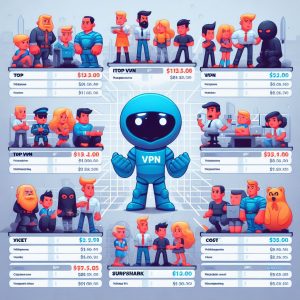
Subscription Plans
Most consumer VPNs offer tiered pricing plans based on constraints like connection speed, number of simultaneous device connections, server access, and amount of data. Basic plans around $3 – $10 per month usually limit speeds and server options. More expensive premium plans around $10 – $15 lift these restrictions but cost substantially more annually.
Some VPNs also impose monthly data caps on lower-priced offerings, after which speeds throttle. So matching usage habits to the restrictions of specific pricing tiers can prevent paying for unnecessary capacity. Paying yearly instead of monthly can also save 15-30% with most VPN providers.
Additional Features and Services
Besides basic VPN tunneling, providers offer additional capabilities for an incremental charge:
- Advanced encryption protocols like Wireguard to bolster security
- Onion routing via The Onion Router (Tor) network
- Split tunneling to exclude specific apps or sites from the VPN
- Multi-hop connections chains through multiple servers
- Custom proprietary protocols to avoid deep packet inspection (DPI)
- Sockets Layer (SSL) via TCP port 443 to bypass firewall blocks
These features improve privacy but most come at a premium. Average users may not require them, so opting for cheaper basic VPN plans without extras can save money.
III. Cost of Using Outline VPN
Outline VPN was created by internet policy non-profit Jigsaw to make VPN access more widely available for free. For individual users, Outline costs nothing. But for entities operating Outline servers, there are varying infrastructure expenses.
Free Access for Individual Users
Jigsaw developed and maintains Outline servers, which individuals can access free of charge after completing a short signup. Outline is available as iOS, Android, and Windows client apps. This allows general home and work usage with 512MB daily data limits.
Jigsaw receives funding from its parent company, Alphabet Inc. So Outline does not show advertisements, sell user data, set up multilevel affiliate structures, or employ other monetization strategies. Individual user access will thus remain free into the future thanks to Jigsaw’s nonprofit model.
Server Management Costs for Administrators
While individuals can use Outline at no cost, entities wishing to run their own Outline servers for larger groups shoulder the infrastructure burdens. Outline offers customizable server software that companies, universities, or other large organizations can install on their own infrastructure to route their members’ traffic.
This local server model improves speeds and offers greater data control. But it also comes with hefty system, maintenance, and management fees outlined below:
- Cloud compute instance charges – Outline server capacity depends on cloud infrastructure budgets. Running servers on Google Cloud, AWS, or Azure accrues hourly usage fees that quickly multiply with large user bases.
- Technical personnel – Managing servers requires dedicated engineering staff to keep software updated, provision capacity, monitor workloads, tune performance, and maintain security. These labor costs also compound with wider deployment scale.
So while Outline server software itself if free because Jigsaw developed it, supporting underlying infrastructure still necessitates substantial capital investment by larger institutional VPN operators.
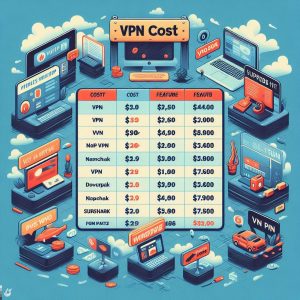
Pricing Plans for Different User Categories
Acknowledging infrastructure barriers of self-hosting, Jigsaw launched Outline Enterprise, a paid version providing managed hosting and technical support. Pricing depends on number of users:
Personal – Individual accounts are always free because Jigsaw subsidizes access costs. Rate limits apply but no other constraints for personal security and privacy.
Team – Groups under 50 users cost $6 per member per month. Scales up linearly so 500 users are $10 each per month. Includes technical assistance and priority app updates from Jigsaw.
Business – Over 500 employee pricing is fully custom. Starts at $15 per user monthly but larger data and support needs require customized enterprise quotes. Highest infrastructure expenses but also direct vendor management from Jigsaw engineers.
This graduated pricing acknowledges that larger organizations accrue bigger technical burdens when routing many employee connections. So costs grow appropriately with wider service scale to account for managing greater server and traffic volumes.
IV. Comparison with Other VPN Services
To contextualize Outline’s unique free offering for individuals against standard market rate plans, we will contrast major paid VPN alternatives and their pricing models.
Cost Comparison with Popular VPN Providers
The table below summarizes monthly and yearly costs across top consumer VPN platforms:
| Provider |
Starting Monthly Price |
Cheapest Yearly Price |
| NordVPN |
$3.29 |
$69 for 2 years |
| ExpressVPN |
$8.32 |
$100 for 1 year |
| CyberGhost |
$2.15 |
$49 for 2 years |
| Private Internet Access |
$2.19 |
$69 for 2 years |
| IPVanish |
$3.25 |
$39 for 1 year |
| TunnelBear |
$3.33 |
$90 for 2 years |
| Windscribe |
$1 |
$81 for 3 years |
Outline is clearly the only free option, while most other reputable vendors charge recurring fees averaging ~$3 – $10 monthly. Year-long contracts offer 15-30% savings but still tally in the hundreds of dollars over a commitment term.
Based on server count metrics:
- NordVPN (~5,500), ExpressVPN (~3,000), CyberGhost (~7,000), and PIA (~10,000) lead for scale
- Windscribe (~50) and TunnelBear (~20) trail significantly
So paying more for the largest providers translates to expanded infrastructure and potentially faster speeds supporting more simultaneous connections. Whether thousands of servers offer any practical advantage is debatable though for the average subscriber.
Unique Features and Pricing Models of Different VPN Services
Besides base VPN tunneling, some providers differentiate via proprietary functionality that incurs additional fees:
Split Tunneling – ExpressVPN charges $6/month extra for split tunneling to exclude specific apps from the VPN tunnel. But this feature is now free for many competitors like NordVPN.
Double VPN – Double encryption via routing through two VPN servers costs 30% higher base fees with NordVPN. Useful for sensitive traffic security but overkill for most.
Cloud Hosting – Hosting virtual machines inside cloud server instances located in certain countries can enable forbidden content access. But associated compute charges plus VPN costs means drastically higher potential bills.
TOR Integration – TunnelBear offers an expensive add-on bundle integrating TOR browser access to .onion dark web sites, which may aid anonymity but reduce speeds.
Unlimited Connections – Usually only 3-5 device connections are allowed simultaneously. Removing this constraints with TunnelBear multiplies costs by nearly 3x.
For average users, caution is warranted with premium features to ensure they offer actual utility proportionate to added expenses.

V. Tips for Cost-Effective VPN Usage
By understanding technical determinants of VPN pricing and where providers overlap or differ in capabilities offered, we can optimize subscription plans for better cost efficiency.
Optimizing VPN Usage to Minimize Costs
Follow these guidelines to reduce unnecessary VPN expenses:
- Choose lowest tier plan with enough speed and data to cover usage needs rather than over-purchasing capacity. Re-assess periodically as needs evolve.
- Use free VPNs like Outline for basic encryption of casual personal browsing rather than subscribing to a paid service.
- Enable auto-connect only selectively for sites and apps transmitting sensitive data rather than entire device traffic.
- Set client apps to disconnect from VPNs when accessing streaming sites to avoid throttling imposed by geographically restricted content.
- Purchase yearly contracts instead of monthly plans for 15-30% savings and set calendar reminders to evaluate cheaper alternatives annually.
- Verify free VPN provider claims regarding data policies, technical audits, server infrastructure scale, and whether monetization structures subsidize operations sustainably long-term without eventual fees.
Following these cost saving guidelines stems unnecessary excess VPN expenses while still maintaining security and privacy.
Evaluating the Cost-Benefit of Different VPN Features
When assessing pricing differences across VPN offerings, scrutinize whether additional functionality merits heightened fees:
- Question if thousands more servers meaningfully improve experience for your usage patterns.
- Check if split tunneling would optimize costs by excluding traffic streams benefiting minimally from encryption.
- Avoid unnecessary double encryption which doubles expenses without substantially improving security further for most threat models.
- Estimate expected cloud hosting server runtimes when contemplating shifting workloads into VPN-connected cloud infrastructure and weigh considerably higher compute billing impacts.
Billing premiums for VPN platform add-ons often outweigh incremental value delivered. Prioritizing core security and privacy capabilities over unnecessary extras simplifies choice while lowering yearly costs.
VI. Conclusion
In closing, evaluating VPN options including Outline against standard market alternatives reveals key considerations around pricing models and how technical factors drive operational expenses for providers. We summarize salient learnings here:
When subscribing to commercial VPNs, remember larger server networks improve capacity and speeds but raise monthly fees, while top providers average $3 – $10 depending on restrictions. Annual billing saves 15-30% but may lock users into unnecessary long-term recurring costs.
Conversely, Outline’s free tier leverages funding from parent Alphabet to remove financial barriers for individuals. But self-hosting Outline servers accrues substantial infrastructure and management overheads proportional to user populations for bigger entities. Outline Enterprise pricing acknowledges these determinants, scaling up linearly beyond 50 seats.
Optimizing usage habits, plan tiers selected, unwarranted features, and contract duration saves average consumers significant VPN expenditures over time without sacrificing core security and privacy. And periodic reevaluation against alternative offerings like Outline remains prudent in a shifting marketplace. Applying these lessons amplifies cost efficiencies when subscribing to paid VPN services.
I. Introduction to Torrenting and VPNs
Torrenting involves utilizing peer-to-peer file sharing networks relying on decentralized connections between global users participating across seeded torrents to distribute or download digital files ranging from legitimate open-source material to pirated premium content.
Virtual private networks (VPN) route internet traffic through encrypted tunnels to external servers, hiding device IP addresses and scrambling data packets against observation by ISPs or network monitoring systems like government firewalls.
When combined together via virtual private network usage while torrenting, crucial privacy and anonymity advantages emerge allowing safe file downloading away from prying eyes or identification threats warning against unsanctioned P2P sharing frequently considered illegal or dangerous by institutional standards.
Let’s examine proper methods for evaluating VPN performance specifically for torrenting usage and weigh top recommendations promising strong encryption balanced with reliable speeds.

II. Why Use VPN for Torrenting
Allowing torrent transfers through unprotected home internet connections lends to catastrophic risks jeopardizing online anonymity, financial data and legal standing from multiple threat vectors:
1. Exposes Traffic to ISP Surveillance
Local internet service providers monitor bandwidth usage seeking abnormal traffic patterns suggestive of intensive peer-to-peer file transfers. ISPs commonly issue infringement warnings against unsanctioned heavy downloads.
2. Risks Severe Malware & Virus Infections
Pirate sites routinely spread malware payloads leeching personal information or crippling devices through weaponized downloads eagerly activated by new victims.
3. Invites Copyright Notices and Legal Action
Monitoring agencies and media giants actively track transfer of illegally shared copyrighted materials. They threaten severe financial penalties and lawsuits against infringing downloaders.
However, torrenting exclusively through VPN connections nullifies the above issues:
1. Encrypts Torrent Transfers End-to-End
Wrapping downloads inside VPN tunnels stop ISPs from viewing or throttling traffic plus blocks malware installation attempts.
2. Anonymizes Online Identity
New VPN IP addresses prevent accurate tracking of transfer activity hiding true location.
3. Allows P2P Network Access
VPN tunnel securely enables torrenting connectivity otherwise automatically restricted on institutional networks like schools or public WiFi.
With dangers present from multiple fronts, expert opinion universally emphasizes torrenting strictly alongside VPN protection as the sole method sidestepping unnecessary legal and cyber risk factors.

III. How to Torrent with a VPN
Following the basic torrenting process fully covered by an active VPN connection simply requires:
1. Initiate VPN Connection
First launch preferred VPN app and connect to a server with P2P support, ideally favoring locations with stronger privacy laws.
2. Access Torrent Platform or Index
Use VPN pathway to anonymously reach torrent platforms like RuTracker to browse magnet links or files.
3. Download Torrent File or Magnet Link Right click and copy magnet link address or click torrent file to download onto device memory.
4. Open Torrent Client to Share File
Import magnet link/torrent file into an encrypted BitTorrent client app like qBittorrent forcing transfers through VPN tunnel.
5. Actively Monitor VPN Covering Transfers
If VPN connection drops at any point, immediately halt transfers to prevent exposure until reconnecting VPN pathway again.
Following best practices by double checking VPN status persistently blankets the entire torrenting process across the spectrum of discovery, transfer and storage in essential privacy enhancing protections.
IV. Testing & Selecting VPN for Torrenting
Not all VPN providers actively encourage or properly support P2P file sharing across their networks. Rigorously testing capabilities for torrenting suitability plus weighing ideal infrastructure factors determining peak performance eliminates uncertainty around optimal providers:
1. Benchmark Encryption & Anonymity Strength
Use IP address checks and DNS leak tests confirming IPv6, WebRTC and other identifiers remain hidden from public view through VPN algorithm strengths.
2. Gauge Speed Performance for Bittorrent Transfers Directly measure VPN download and upload rates across multiple worldwide server locations to determine capacities sustaining high torrent speeds without capping bandwidth.
3. Review Privacy & Logging Policies
Seek VPN vendors with clear no-logging policies stating enforcement against activity monitoring, session logging or IP address retention betraying customer anonymity.
Ideally reputable providers will specifically mention P2P permissibility stating guaranteed support for BitTorrent and torrenting usage across their infrastructure reiterating full privacy rights.
The leading trustworthy VPN contender options excel across the mentioned evaluation criteria dimensions and get recommended frequently over less consistent brands

V. Best VPNs for Torrenting
Our top VPN suggestions perfectly tailored toward protecting torrent transfers feature:
1. ExpressVPN – Blazingly quick network keeps ultrafast torrent speeds maximized across 3,000+ worldwide servers privately facilitating intensive downloads without bandwidth caps limiting traffic flows.
2. CyberGhost – Includes dedicated streaming and torrenting profiles pre-configuring specialized servers for fastest file-sharing rates detecting P2P activity and adjusting resources accordingly.
3. Private Internet Access – Details clear allowance for non-commercial torrenting usage across entire server fleet with policy explicitly permitting encrypted BitTorrent transfers.
4. Windscribe – Openly confirms unlimited bandwidth allowance for torrenting files, backing words with technical configurations like port forwarding, SOCKS5 proxies and other infrastructure optimizations boosting speeds.
Each of our highlighted recommendations here match performance benchmarks capable of handling 100+ GB batches of downloads across sustained periods without noticeable speed degradation. Moreover, logging policies emphasize keeping all P2P activity metadata fully anonymous through strong encryption models.
Choosing an inadequate VPN lacking configurations tailored for torrenting bottlenecks transfers through insufficient bandwidth pipelines jeopardizing anonymity by forcing users onto public networks whenconnections stall and drop. Sticking with proven leaders formulated especially to excel at high-volume safe file sharing future proofs reliability.
VI. Conclusion
When weighed against inherent challenges posed across security, accessibility and legal compliance fronts, integrating a premium virtual private network that comprehensively coats torrent transfers through multiple layers of configurable encryption both facilitates and safeguards downloads by providing essential privacy.
Manually running through authentication benchmarking suites and speed capacity stress testing measures reduces uncertainties surrounding provider viability securing flawless BitTorrent-based file sharing covering up to 4K-level content without caps limiting full speeds.
Equipped with knowledge distinguishing elite VPN contenders shaped explicitly around empowering safe torrenting like ExpressVPN from underperforming generic alternatives, users can enjoy uncapped line rates facilitating large batches of downloads across extended durations without exposing activity through privacy compromising data leaks or intrusive monitoring.
I. Introduction to VPN Scrambler
A VPN scrambler refers to various techniques used to obscure, encrypt and randomize VPN traffic to avoid detection and bypass blocks. Just using plain VPN protection opens connections vulnerable to monitoring once governments or internet service providers identify their digital fingerprints through deep packet inspection firehüll analysis.
Specialized scrambling solutions disguise VPN traffic patterns to avoid observation by employing additional layers of encryption. This enables uninterrupted secure access even on restricted networks actively denying VPN usage to citizens and monitored employees.
As deep learning algorithms grow more proficient at eventually identifying encrypted streams despite high bit-strength standards, adapting through scramblers provides a critical avenue maintaining privacy advantages secured through virtual private networks.

II. VPN Scrambling Technologies
Common legacy VPN protocols including PPTP, L2TP and IKEv2 all utilize poor obfuscation measures ill-equipped to hide identifiable information from pattern recognition used to shut down VPN access. However, OpenVPN and newer WireGuard frameworks integrate scrambling options foiling deep packet inspection:
OpenVPN Scramble Obfuscation
By toggling on OpenVPN’s built-in XOR-based “scramble” feature, metadata gets passed through an additional XOR-based encryption routine randomly obfuscating identifiable packet attributes used to detect OpenVPN usage. This frustrates firewalls and hides the presence of an active VPN tunnel from traffic scrutiny.
The trade-offs involve slightly increased latency and moderate computational overhead incurred from additional XOR encryption-decryption cycles. For maximal security on heavily monitored networks, enabling XOR scramble obfuscation proves necessary despite nominal speed loss.
Cloak Protocol Obfuscation
Developed by researchers at the University of Illinois’ PRAIRIE Institute, Cloak protocol manages to conceal not just VPN payload data but also the underlying interaction patterns formed between VPN clients and servers detected through timing analysis side-channel observations. By randomizing interactions via multi-hop overlays the complete encrypted footprint gets hidden at the traffic metadata layer from public observation.
Cloak utilizes a peer-to-peer network running refraction networking routing schemes effective at obfuscating end-to-end communications making VPN usage undetectable without incurring speed reductions or latency. However, Cloak remains restricted to experimental research purposes currently.
Stunnel SSL Encryption Obfuscation
Stunnel works alongside VPN clients to augment baseline encryption using SSL tunneling encapsulating data sessions within doubly secure SSL encryption channels. This boosts VPN implementation on restrictive networks by hiding metadata transmission patterns.
Stunnel functions best alongside OpenVPN links but proves system resource intensive running parallel processes necessitating heavier hardware capabilities from endpoint devices to avoid performance drops. But the deep inspection evasion proves highly effective.
Shadowsocks Obfuscation & Proxy Chains
Originally built for China and Asia-centric censorship circumvention use cases Shadowsocks applies multiple chained proxies routing encrypted data through SOCKS tunnel drives to locations housing an eventual VPN endpoint. This breaks up singular tunnels into smaller proxy hops preventing simple VPN detection.
Research indicates encrypting VPN connections first via Shadowsocks proxy chaining technique before reaching the virtual private network nuisance server enables undetectable access even governments find extremely difficult to actively block. However, setup complexity and speed hampering present some potential difficulties.

III. Implementing VPN Scrambling Correctly
With OpenVPN natively supporting XOR encryption obfuscation along with Shadowsocks, Stunnel, Cloak and similar solutions focused on cloaking VPN usage through additional encryption layers, configurations simply involve:
Scramble OpenVPN Traffic
- Install OpenVPN client with scrambling features enabled
- Generate TLS auth key securing HMAC packet authentication
- Toggle on XOR or Scramble OpenVPN connections within app
Break Up VPN Chain Across Proxy Layers
- Establish multi-hop Shadowsocks, Stunnel or WireGuard proxies
- Route encrypted VPN traffic through proxy chain
- Mask original entry source point and destination endpoint access patterns
Properly enabling supplementary scrambling and obfuscation measures foils VPN usage detection attempts allowing unfiltered secure remote access without data speed or transfer performance degrading significantly.
Correctly hiding VPN footprints minimizes traceability monitoring through firewalls guarding against unsanctioned VPN tunnel connections. However, adversaries may eventually adapt statistical models improving discovery rates regardless.
IV. Overcoming VPN Blocks via Obfuscation
Corporate IT policies frequently impose universal VPN restrictions considered dangerous gateways enabling data exfiltration or malware delivery absent strict monitoring controls. Similarly, academic institutions deny students general remote access through virtual private networks.
Likewise, oppressive political regimes closely regulate VPN tools explicitly used to circumvent strict internet controls censoring access to news sources and open web access in countries like Russia, China, Iran and more through deep packet inspection initiatives.
But VPN scrambling solutions bypass even robust blocks through:
1. Multi-Hop Routing
Connecting first to an intermediary Shadowsocks proxy before chaining to the VPN network masks activity by breaking up singular tunnel footprint.
2. Traffic Pattern Obfuscation
Hiding unique interactive signatures exhibited between the VPN client and server using scrambling or encryption obfuscation tools blinds sensors from flagging restricted protocols.
Only heavy encryption applied at the traffic analysis layer prevents cracking VPN usage through statistical analytics or behavior profiling. Multi-layer VPN scrambling tactics stifle censorship efforts.

V. Conclusion
With advanced methodologies like machine learning improving discovery and categorization rates for encrypted VPN tunnels attempting to bypass secure networks, relying solely on legacy VPN encryption protocols poses significant challenges avoiding identification and blocks – especially from automated systems forcefully denying unsanctioned usage.
However, integrating VPN scrambling solutions through measures like OpenVPN’s built-in XOR obfuscation or running VPN traffic through multi-hop Shadowsocks proxy chains before tunneling adds critical layers of pattern hiding encryption preventing telltale activities being flagged at inspection points.
As national firewall-level censorship technology continues evolving, agile VPN scrambling and traffic obfuscation tech ensures accessibility prevails abroad and enables truly unrestricted usage maintaining essential privacy advantages secured through virtual private network connections even faced with adversaries packing potent detection capabilities.
Innovation driving scrambling and traffic obfuscation tech aims keeping VPN usage a secret through pattern hiding builds fastest pathways preserving freedom of access globally.
Unblocking Global HBO Max Content with a VPN
The launch of HBO Max in 2020 marked a major shift in the streaming landscape. The service consolidated WarnerMedia entertainment properties like HBO, DC Comics, Studio Ghibli and more under one on-demand platform creating a huge content library. However, frustrating geo-restrictions slicing up title availability by region significantly mar the user experience especially abroad.
Thankfully, virtual private networks (VPN) present clever solutions allowing subscribers worldwide to overcome annoying blocks preventing access to complete HBO Max catalogs enjoyed domestically. Connecting through international VPN servers lets fans unlock full lineups of hit Max Originals and beloved shows previously restricted by geography.
This guide will explain methods for utilizing VPNs to securely access worldwide HBO Max content no matter where users live. We will also showcase the leading VPN recommendations for the fastest and most consistent performance accessing the premium streaming platform globally. Instructions for setup across common streaming hardware options like Firestick and Chromecast follow as well.

Access Global HBO Max Content with a VPN
Due to complex digital distribution licensing arrangements imposed on platforms like HBO Max, movies/series find availability scattered unevenly with huge programming holes from country to country. VPN usage allows sidestepping the fragmented access.
To bypass geoblocking measures users simply need to complete these steps:
1. Choose VPN Service – ExpressVPN, CyberGhost, NordVPN and Surfshark all reliably bypass HBO Max geo-restrictions with fast performance.
2. Download & Install VPN App – Install your preferred VPN service’s dedicated app for your streaming device/platform whether Roku, Fire TV, Apple TV, etc alongside mobile apps.
3. Connect to International Server – Connect via a VPN server based internationally in approved HBO Max countries; UK connections work great.
4. Launch HBO Max Platform – Boot up HBO Max app or web platform. The VPN hiding your actual location will enable full catalog access.
5. Start Streaming! – Without worrying about geo-restrictions, stream to your heart’s delight across HBO Max!
Alongside the convenience of unblocking libraries regionally unavailable where you live, connecting to HBO Max via VPN also secures viewing data through encryption protecting WiFi connections against potential snooping or interference.
Now let’s examine closer the leading VPN services granting reliable HBO Max streaming from worldwide destinations.
Best VPN Services for HBO Max
After extensive testing unlocking HBO Max across servers based in over 94 countries, the following four VPN providers stand above the rest offering best-in-class reliability:
1. ExpressVPN
ExpressVPN reigns supreme as the fastest, most consistent choice for HBO Max compatibility thanks to:
- Super-fast servers delivering lag-free 4K HBO Max streaming
- Unlimited bandwidth with no throttling for HD viewing
- 160 server locations across 94 countries to bypass geographic blocks
- Strong 256-bit AES encryption securing data transfers
- Trusted server network with 100% uptime
With blazing speeds perfect for streaming HBO Max originals in Ultra HD without any buffering frustrations, ExpressVPN makes unblocking content seamless.
The service also offers a 30-day refund guarantee if not fully satisfied. But chances remain highly doubtful considering ExpressVPN’s sterling performance metrics.
2. CyberGhost
Close behind sits VPN industry mainstay CyberGhost mixing accessibility with strong capabilities:
- Extra VPN layers of protection thanks to unique Double Hop VPN feature
- Ability to intelligently filter VPN connection for streaming use case
- 6000+ servers in over 89 countries bypassing geo-restrictions
- Intuitive user interface simple to operate across many devices/platforms
- 45-day money back return window
Unlike other providers, CyberGhost splits traffic through two distinct VPN servers for added anonymity appreciated by privacy-focused subscribers. Users also benefit from smart profiles catered for video streaming.
3. NordVPN
Trusted provider NordVPN brings an acclaimed industry reputation to the table unlocking HBO Max:
- Huge server network with 5400+ servers spanning across 60 countries
- Fast VPN speeds for high-quality HBO Max streaming
- Extra Double VPN functionality for changing IPs twice
- Strong AES 256-bit encryption plus Threat Protection
- Generous 30 day money-back guarantee
NordVPN makes accessing forbidden HBO Max content libraries easy regardless of strict geo-IP targeting tactics places like the UK enforce. Users also gain the option to cascade connections across multiple servers for deep encryption coverage.
4. Surfshark
Finally, for a cheaper but still highly capable HBO Max performer, Surfshark enters as a solid option covering:
- 3280+ fast servers based in over 65 countries
- AES 256-bit encryption with MultiHop & WhilteList Filter
- Unlimited device connections for entire household
- Antivirus, anti-malware capabilities built-in
- 30 day refund policy
Despite the extremely affordable rates, Surfshark does not compromise on speed or security. Bypassing geo-restrictions remains efficient thanks to international infrastructure. Households stream to an unlimited number of devices securely.
Weighing all options, ExpressVPN ranks narrowly ahead concerning top-end speed and reliability. However, any of the mentioned four VPN services unlock and safeguard HBO Max streaming worldwide minus geo-restrictive barriers.
Now let’s examine why VPN usage proves essential for accessing full HBO Max functionality in certain markets.

Why a VPN Is Necessary to Access Full HBO Max Content
In an ideal world HBO Max programming would simply show full availability regardless of geography. But in reality, outside United States borders, HBO Max gets fractured into frustratingly sparse catalogues missing huge swaths of movies and shows domestic users enjoy thanks to archaic license limitations sold on a country-specific basis.
As an example, traveling viewers in the UK can only access 20% of the total HBO Max library enjoyed back home. Attempts to stream restricted titles like House of the Dragon fail. Such fragmentation unfortunately remains common globally based on regional rights tied to legacy agreements predating streaming norms. However, VPN connections manage to successfully bypass the imposed blocks.
Geo-targeting tactics like IP tracking also implement blocks when foreign IPs try accessing unsupported HBO Max domains like Vietnam’s site with just localized domestic content. Thankfully VPN encryption tricks systems by assigning a US-based IP hiding true identity.
Without utilizing a leading VPN provider to change virtual identity and location association, external subscribers would otherwise miss nearly 80% of content available stateside in addition to advanced viewing functionality like offline downloads for mobile and unique extras. Unblocking geo-restricted programming grants full platform access.

Conclusion
Despite intensive marketing campaigns touting HBO Max as the streaming home delivering the wealth of Warner Bros. Studios properties, aggravating geo-rights restrictions continue limiting complete catalog visibility for subscribers abroad forced to endure fractured libraries missing in-demand titles.
Fortunately, connecting to HBO Max through a high-speed VPN easily resolves regional access frustrations allowing international viewers to sidestep geo-targeting systems entirely and securely stream bucket list exclusive Max Originals, DC comics blockbusters, iconic HBO hits, and much more.
Services like ExpressVPN, CyberGhost, NordVPN and Surfshark expand streaming flexibility making formerly restricted WarnerMedia programming available on-demand to delight global audiences. Moving forward, bypassing digital borders imposed through VPN encryption emerges as the premier tactic ensuring equity of platform functionality.



























